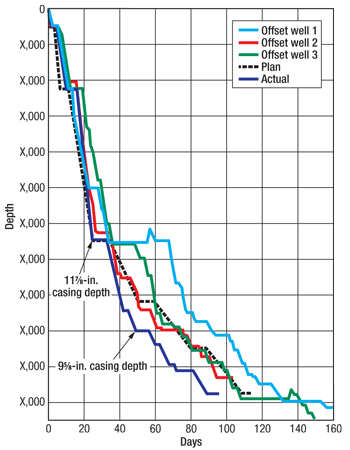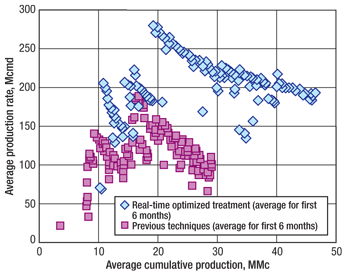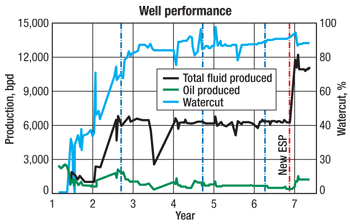Coupling real-time technologies with predictive decision making creates potential for a step change in well construction and production.
Kevin Goy, Schlumberger
The first data transmission from a remote oilfield location was initiated in 1964 using microwave radios. In the early 1980s, the use of satellite technology (VSAT) for wellsite data transmission created a new industry standard. Today, remote access to an increasing number of real-time wellsite data sources combines with powerful analytical software, enabling experts and stakeholders to address challenges, regardless of their physical locations.
Within the oil and gas industry, being “real-time enabled” has a variety of meanings depending on the audience. Asset managers, IT professionals, petrophysists, geologists and drilling engineers will use real-time data differently, and therefore will place different values on this data.
In its simplest form, the use of real-time data in the oil and gas industry resembles many of the real-time processes utilized in peoples’ daily lives. Checking stock market activity online is analogous to receiving well logging data in one’s office just seconds after acquisition downhole. Finding the way to a previously unvisited destination with a GPS device in an automobile is much like well placement with the latest subsurface information to guide the user. Glancing at a “real-time” traffic map before leaving the home or office allows one to make decisions on how to reach one’s destination in the shortest time based on the most up-to-date information, similar to identifying drilling hazards during the well construction process.
Domain experts are able to remotely monitor, model and manage well construction and production operations 24/7. With a focus on performance and safety assurance, remote operations traditionally managed by well-trained field crews now have the added benefit of senior experts providing a cross-check in real time. Using advanced workflows, interventions by these expert teams working at information centers far from the wellsite (known within Schlumberger as operation support centers, or OSCs) have steadily increased, yielding significant service quality gains.
BENEFITS OF USING A PREDICTIVE APPROACH
While some have seen success placing remote data monitoring at the core of operation support, the potential for a step change in operational efficiency is yet to be realized by most of the industry. The value of real-time operations is not just in accessing data or viewing it with software, but primarily in modeling of the data to analyze and predict problems. Shifting emphasis from real-time monitoring to a dynamic real-time predictive approach enables an informed decision process to mitigate or eliminate problems while improving performance.
Taking an example from our daily lives, websites providing weather information are used extensively today. Recent advances enable even mobile device owners to view the latest weather radar maps, which identify approaching storm cells and provide a time-lapse view of movement. We make mental deductions as to the potential future movement of those storms and the time at which they may impact us. These mental deductions form the very basis for prediction, enabling powerful, unprecedented decision-making capability. Refresh the screen and an even newer set of data arrives, further enhancing our forecasting ability.
Regardless of how far an operator has progressed along the real-time adoption path, new technologies and services are available across the well construction and production spectrum, the use of which is improving the efficiency of operations and enhancing the value of assets, while lowering total system costs substantially.
PREDICTIVE MODELING TO AID DRILLING
One of the key contributions that an OSC can make is to gather the real-time data streaming in from the wellsite and contextualize it within the well design and fieldwide reservoir knowledge—something difficult to do on the rig. This centralized view paves the way for highly informed approaches to problem solving.
An OSC was established in Colorado to support operators drilling in the Pinedale Anticline in Wyoming. In this region, operators planned to drill several hundred wells per year. The time to drill and complete a typical well stood at 35 days through 2007, and a target was set to reduce this to 15 days. Achieving this target would result in a savings of about 2,190 combined rig days a year, thus saving the operator over $100 million.
A strategy with two main elements was developed: 1) a powered rotary steerable service for vertical drilling and 2) remote optimization via the OSC using real-time drilling data acquired on all rigs.1 This approach allowed for no rotary steerable operations personnel to be based at the wellsite during drilling. Newly developed OSC-centric processes and procedures increased efficiency while allowing for fast deployment across a fleet of rigs. The process included a rig-up crew that moved from rig to rig for BHA pickup or laydown.
The remote operations team then monitored operations in real time and began analysis to optimize performance. Using offset data and mean-specific-energy (MSE) techniques, drilling performance targets were set for each depth interval. OSC-based drilling engineers communicated observations of drilling mechanics trends to the driller aided by advanced modeling/prediction software and recommended changes in the drilling setup to mitigate problems and improve performance. Additionally, OSC personnel alerted the rig when penetration rates were compromised by adverse drilling dynamics, or when input energy needed to be reduced to preserve bit life and minimize trips.
This method of challenging the target was complemented by the operator’s ongoing optimization initiatives and resulted in an increased average rate of penetration (ROP) of 36%, with the average time to drill and complete these wells substantially reduced from the original benchmark.
HAZARD MITIGATION USING GEOMECHANICS
Many drilling-related failures are caused by unstable boreholes resulting from lost circulation, packoff or stuck BHAs or casing. Methodologies to model and forecast borehole stability and to use this predrill knowledge in real time enable operators to minimize formation-related drilling problems.
The operator of a Gulf of Mexico field had a history of NPT related to wellbore stability problems. The most recent well had experienced losses, influx, stuck pipe and cementing challenges. The operator decided to use real-time drilling geomechanics services to make more informed decisions during drilling operations. Geomechanics experts used offset well information to build a temperature-dependent predrill pore pressure model. Engineers in the OSC continued real-time monitoring of drilling operations to update and recalibrate the pressure model using all available data, including gas information, leakoff tests, formation integration tests and logging-while-drilling resistivity and gamma ray data.
The OSC provided drilling risk forecasts and recommendations to the offshore and onshore drilling team through daily updates, or more frequently as needed. The real-time geomechanics workflow and modeling predicted and mitigated wellbore stability issues during drilling. This process calculated a pore pressure ramp that was shallower and of greater magnitude than was anticipated from offset well information. This resulted in an informed decision to set the 11⅞-in. casing early. The 9⅝-in. casing was then pushed 1,700 ft deeper than planned, as further real-time modeling indicated that no stability issues would be encountered. The operator therefore had the flexibility to save a liner string or finish the well in a 7½-in. hole.
As the 9⅞-in. hole was drilled below the 9⅝-in. casing, real-time geomechanics modeling predicted a severe tightening of the mud weight window, requiring an unplanned 7¾-in. casing string. Although the well was landed using a 6½ × 7½-in. bit, a slimhole section was avoided because the 9⅝-in. casing had been pushed much deeper than expected, Fig. 1.
 |
|
Fig. 1. Real-time drilling geomechanics helped exceed the operator’s expected technical limit, reducing time to TD.
|
|
High-quality real-time data and timely predictions enabled each hole section to be completed ahead of schedule with no losses, stuck pipe incidents or influx—reducing the risk of NPT. Additionally, the improved drilling process helped eliminate remedial cementing work as hole cleaning issues were minimized.
RESERVOIR CHARACTERIZATION
Understanding reservoir architecture and complexity means understanding the reservoir fluid (its type and distribution) as well as the rock. Conventional methods of fluid evaluation such as drill stem testing and production testing do not allow for point-by-point evaluation of the fluid column. This task has fallen to families of wireline formation testers and associated downhole fluid analyzers (DFAs). A case in point is the recent evaluation of a complex reservoir in the North Sea.2 An exploration well into the reservoir had determined that the fluid column was quite complex. A compositional gradient combined with possible reservoir compartmentalization was identified, and an appraisal well was planned to allow evaluation of the fluid type and distribution upon which the economic success of the project would depend.
The evaluation plan consisted of using an equation-of-state (EOS) model to predict the fluid analyzer response at various locations in the reservoir penetrated by the appraisal well.3 The fluid analyzer would then be run and actual responses measured. Real-time comparisons would be made of predicted and measured data obtained from the wireline formation tester logging run. Agreement of predicted and measured log data would indicate that fluid properties and reservoir connectivity used for the modeling were correct. If the predictions disagreed with the measurements, then the acquisition program could be altered in real time to ensure acquisition of sufficient data to understand the reservoir model inaccuracies.
This highly interactive operation would require input from engineers well versed in both fluid analyzer interpretation and EOS modeling. This type of knowledge is not typically available at the wellsite, so an interactive real-time link is required. With this link, the same engineers that built the EOS model can have access to the real-time data from the fluid analyses in the appraisal well, as well as drive the acquisition process for further fluid analysis.
This example is demonstrative of the increasing complexity of formation tester interpretation, which means that the field engineers tasked with maintaining and running the formation testers cannot also be expected to be fully conversant in the interpretation and modeling of the acquired data. This task must be left to experienced reservoir engineers equipped with knowledge of the reservoir and the required software tools to properly integrate the measurements. A functional real-time network with sufficient capacity and bandwidth is the only way to efficiently bring these two together.
OPTIMIZATION OF STIMULATION TREATMENTS
Adequately acid stimulating long horizontal openhole sections in naturally fractured reservoirs has long been challenging. Higher-permeability zones are more successfully treated due to the tendency for stimulation fluids to migrate toward these easier flow paths, leaving low-permeability zones nearly untouched. While many products and techniques have been developed to improve wellbore coverage and reservoir drainage, adequate evaluation of their effectiveness has been difficult at best.
A new diverting technique designed to improve placement while also providing in situ evaluation of the treatment in real time has been developed in Western Canada.4 State-of-the-art viscoelastic acid diversion combined with fiber optic technology has proven effective in the placement of stimulation fluids. Distributed temperature surveys (DTS) and single-point downhole pressure and temperature measurements are analyzed in real time and modeled with available petrophysical information to provide an in situ identification of all dominant thief zones. This real-time analysis allows for on-the-fly modification of the treatment schedule, with the objective of fully homogeneous stimulation of the pay zone.
In a Southern Alberta field, several wells were stimulated using this technique, with horizontal sections as long as 2,500 m with a fieldwide average of 1,800 m. Previous treatments pumped 20% or 28% HCl at a rate of 150−200 L per meter of wellbore. The volume of acid was increased over previously determined high-grade reservoir sections during a single pass with coiled tubing. While best practices were used to distribute the acid where required, highly conductive fractures throughout the wellbore resulted in ineffective stimulation, as quantified through inconsistent production results across the field.
An effective chemical diversion was needed to distribute the treatment fluids more evenly across the pay zone. Successful diversion across a long openhole section employing a blind placement schedule is very reliant on log interpretation to identify potential thief zones, which may or may not be real. The real-time matrix stimulation process uses petrophysical data, real-time intelligent coiled tubing parameters, and the real-time DTS information. The real-time modeling evaluation of all three data sets allows for reliable identification of intake points, and the pumping schedule is modified accordingly to focus diversion materials at determined take points.
The matrix stimulation treatment procedure involves using this technology to complete eight coiled tubing passes across the pay zone. A DTS is acquired and analyzed upon reaching the toe after each inward pass. The first openhole pass is performed while circulating jetted fresh water in an effort to remove residual drilling fluid. The DTS information from this pass may indicate take points and captures the thermal response of the reservoir rock to a nonreactive fluid.
Acid is squeezed while making the second and third passes. Typically, a pressure breakdown is noted during the initial acid squeeze. At the end of the third pass, when the end of the coiled tubing is back at the toe of the well, a second DTS acquisition and analysis is performed to qualitatively identify intake points previously created.
The fourth pass targets diversion placement on take points identified from the second DTS while pulling back to the heel of the well. The fifth pass targets treatment acid placement across the areas of high-graded reservoir that do not appear to have been broken down by previous acid passes. At the end of the fifth pass, the third DTS acquisition and analysis is performed to identify changes.
The next two passes are a repetition of the previous two, in which diversion fluid is spotted across take points on the way out and treatment acid squeezed on the way in to the toe. The fourth and final DTS acquisition and analysis is then performed. The information from the final DTS may or may not be used to determine placement of further acid. The final pull from the toe is a squeeze of overflush fluid.
In this example, wells using this real-time modeling and diversion approach showed a 49% improvement in gas production compared with traditional stimulation techniques previously used, Fig. 2.
 |
|
Fig. 2. Average daily and cumulative production observed using real-time stimulation optimized treatment versus traditional techniques.
|
|
SUBMERSIBLE PUMPS PERFORMANCE
Real-time surveillance and control of electrical submersible pumps (ESPs) enable a single surveillance engineer in an OSC to proactively monitor relevant lift system and reservoir parameters on several hundred wells. Recommendations based on performance analysis can be implemented remotely, often resulting in immediate production increases. Surveillance engineers are also able to initiate remote pump startup and speed control, along with remote resolution of certain pump problems. The result: a step change in production and lift system performance with lower operating costs.
When production from a naturally producing well in Egypt’s Western Desert dropped from 2,300 bpd to 980 bpd because of high watercut, the operator installed an ESP system to improve production. The system was designed to produce 5,000−6,000 bpd, based on an initial productivity index (PI) of 32 bpd/psi. After installing the ESP, the well began steadily producing at 6,250 bpd with an 89% average watercut. After a few months, the well failed electrically because of chemical corrosion of the power cable. During workover, an ESP surveillance and control system was installed along with a variable-speed drive to further optimize the well.
Continuous real-time monitoring and matching showed a PI of 102 bpd/psi, well inflow capabilities that were much higher than expected. Production rate and downhole flowing pressure data points were collected and plotted against time, and an inflow performance relationship (IPR) curve was constructed. It was decided to adjust the targeted production rate to 10,000−12,000 bpd, and a recommendation was made to install a higher-capacity ESP with a flowrate capacity of 8,000−14,000 bpd to cover the range of uncertainty, Fig. 3.
 |
|
Fig. 3. Real-time drilling geomechanics helped exceed the operator’s expected technical limit, reducing time to TD.
|
|
After the new ESP system was installed, production from the well increased as expected, to 11,200 bpd, and watercut fell by 3%. The success of this well and the ESP redesign prompted the operator to repeat the same process in similar wells.
CONCLUSION
Enhancing the use of real-time data monitoring systems with a dynamic real-time predictive approach—coupled with a clear strategy, defined goals and close collaboration between field crews and OSC domain experts—is demonstrating the potential for a step change in well construction and production performance. The analysis/modeling of real-time data provides improved decision-making processes proven to significantly improve operational efficiency and make a measurable impact on overall system costs. 
LITERATURE CITED
1 Estep, N., Parsons, B., Middleton, R. and A. Ahsan Alvi, “Remote optimization improves drilling performance in US land,” SPE 128614 presented at the SPE Intelligent Energy Conference and Exhibition, Utrecht, the Netherlands, March 23–25, 2010.
2 Weinheber, P., Gisolf, A. and V. Achourov, “Wireline formation testing: Networking a globally distributed team for optimal reservoir characterization,” SPE 128661 presented at SPE Intelligent Energy, March 23–25, 2010.
3 Gisolf, A. et al., “Real-time integration of reservoir modeling and formation testing,” SPE 121275 presented at the 2009 SPE EUROPEC/EAGE Annual Exhibition, Amsterdam, June 8–11, 2009.
4 Cantaloube, F., Spickett, R., Yekta, K. and M. Anderson, “Optimization of stimulation treatments in naturally fractured carbonate formations through effective diversion and real-time analysis,” SPE 126136 presented at SPE Intelligent Energy, March 23–25, 2010.
|
THE AUTHORS
|
|

|
Kevin Goy is the global real-time business development manager for Schlumberger. Based in Houston, he oversees the development, implementation and evaluation of the company’s strategic growth of real-time technologies and services. In his 22 years of industry experience, Mr. Goy has developed a vision for the future of Schlumberger real-time applications through various positions in operations, sales management, strategic marketing management and marketing communications management. He earned a BS degree in mechanical engineering from the Rose-Hulman Institute of Technology in 1988 and attended the Columbia University Graduate School of Business in 2001.
|
|






